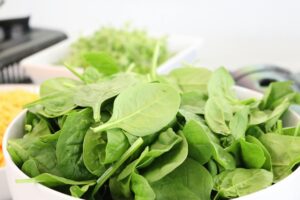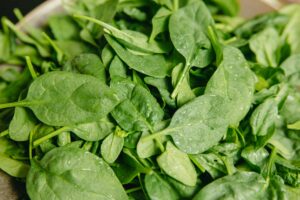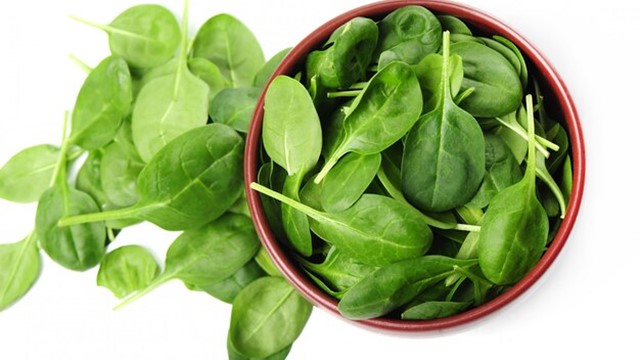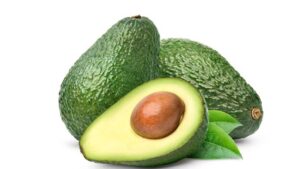Spinach is a leafy green vegetable that belongs to the Amaranthaceae family, scientifically known as Spinacia oleracea. It’s widely cultivated and celebrated for its nutritional value and versatility in cooking. The leaves of the spinach plant are green and typically feature a slightly bitter or earthy taste.
This vegetable is a rich source of various essential nutrients, including vitamins such as A, C, K, and folate, along with minerals like iron, calcium, and magnesium. Spinach is renowned for its antioxidant properties, which can help combat oxidative stress in the body.
Spinach can be consumed raw in salads or sandwiches, or cooked in a variety of dishes, including soups, stir-fries, omelets, curries, and casseroles. Its adaptability in various culinary preparations makes it a popular choice in many cuisines worldwide.

Cultivation and Varieties:
Here’s more detailed information about the cultivation and varieties of spinach:
Cultivation:
- Spinach is a cool-season crop that grows best in temperatures between 35°F to 75°F (1.5°C to 24°C).
- It prefers well-drained soil rich in organic matter and a pH range between 6.0 and 7.0.
- Spinach can be grown directly from seeds or transplants, and it’s typically sown in early spring or late summer for cooler climates. In warmer areas, it’s cultivated during the fall and winter months.
Varieties:

Savoy Spinach:
This variety has crinkled or curly leaves, making it a visually distinct type of spinach. The texture of savoy spinach leaves helps it retain dirt, so thorough washing is necessary before consumption.

Flat-Leaf or Smooth-Leaf Spinach:
These varieties have broader, smoother leaves compared to savoy spinach. They are easier to clean as they don’t trap dirt as much as the savoy type.

Semi-Savoy Spinach:
This variety is a hybrid of savoy and flat-leaf spinach, combining some of the characteristics of both types. It often has slightly crinkled leaves but is easier to clean than savoy spinach.
Planting and Care:
- Spinach seeds should be sown directly into the ground at a depth of around half an inch (1.3 cm). They germinate well in cool soil but might struggle in warmer temperatures.
- Regular watering is crucial, ensuring the soil remains consistently moist without becoming waterlogged.
- Spinach plants are relatively fast-growing and can be ready for harvest within 4-6 weeks after planting.
Harvesting:
- Spinach leaves can be harvested by cutting individual leaves or by cutting the entire plant at the base, allowing for regrowth.
- It’s best to harvest spinach leaves before they reach full maturity to ensure tenderness and prevent bitterness in the leaves.
- Regular harvesting encourages the plant to produce more leaves and extends the harvest period.
Pests and Diseases:
- Common pests that affect spinach include aphids, leafminers, and caterpillars. Proper crop rotation and pest control measures help manage these issues.
- Diseases such as downy mildew and fusarium wilt can affect spinach, but selecting disease-resistant varieties and practicing good sanitation in the garden can help prevent these problems.
Spinach is a relatively easy-to-grow vegetable, and understanding its different varieties, preferred growing conditions, and care requirements can help gardeners cultivate a successful crop of this nutritious leafy green.
Nutritional Profile:
Spinach is celebrated for its exceptional nutritional profile, offering a wide array of vitamins, minerals, and antioxidants essential for maintaining overall health. Here’s a breakdown of the nutritional content of spinach:
Vitamins:
- Vitamin A: Spinach is rich in beta-carotene, a precursor to vitamin A. This vitamin is vital for healthy vision, immune function, and skin health.
- Vitamin C: Known for its antioxidant properties, vitamin C in spinach supports the immune system, aids in collagen production, and enhances iron absorption.
- Vitamin K: Spinach is an excellent source of vitamin K1, essential for blood clotting and bone health. It plays a crucial role in bone metabolism and may reduce the risk of fractures.
- Folate (Vitamin B9): Essential for DNA synthesis and cell division, folate is particularly important during pregnancy for proper fetal development.
Minerals:
- Iron: Though the iron in spinach is non-heme iron (less easily absorbed than heme iron found in animal products), it still contributes to overall iron intake, supporting red blood cell production and oxygen transport.
- Calcium: Important for bone health, muscle function, and nerve transmission, calcium in spinach helps maintain strong bones and teeth.
- Magnesium: Involved in various biochemical reactions in the body, magnesium aids in energy production, muscle function, and nerve transmission.
Other Nutrients:
- Fiber: Spinach contains dietary fiber, which aids in digestion, supports a healthy gut, and may help manage blood sugar levels.
- Antioxidants: Spinach is loaded with antioxidants, including flavonoids, carotenoids (such as lutein and zeaxanthin), and various phytonutrients. These compounds help neutralize harmful free radicals, potentially reducing the risk of chronic diseases like heart disease and certain cancers.
Nutritional Content (per 100 grams of raw spinach):
- Calories: 23 kcal
- Protein: 2.9 grams
- Carbohydrates: 3.6 grams
- Fat: 0.4 grams
- Fiber: 2.2 grams
- Vitamin A: 469 mcg (52% of the Daily Value)
- Vitamin C: 28.1 mg (31% of the Daily Value)
- Vitamin K: 482.9 mcg (402% of the Daily Value)
- Folate: 194 mcg (49% of the Daily Value)
- Iron: 2.7 mg (15% of the Daily Value)
- Calcium: 99 mg (8% of the Daily Value)
- Magnesium: 79 mg (19% of the Daily Value)
Spinach’s impressive nutritional content makes it a valuable addition to a well-rounded and healthy diet, offering an abundance of essential vitamins, minerals, and antioxidants crucial for optimal health and well-being.
Health Benefits:
Spinach offers a multitude of health benefits due to its rich nutritional profile. Incorporating spinach into your diet may contribute to various aspects of overall health. Here are some of the notable health benefits associated with consuming spinach:
- Supports Heart Health: Spinach contains antioxidants like vitamin C, beta-carotene, and flavonoids, which may help reduce oxidative stress and inflammation, potentially lowering the risk of heart disease.
- Aids in Blood Pressure Management: The high potassium content in spinach helps regulate blood pressure by counteracting the effects of sodium in the body, thus supporting cardiovascular health.
- Promotes Eye Health: Spinach is a good source of lutein and zeaxanthin, antioxidants known to accumulate in the eyes and help prevent age-related macular degeneration, reducing the risk of eye disorders.
- Boosts Bone Health: Rich in vitamin K, calcium, and magnesium, spinach contributes to bone health by supporting bone density and strength, reducing the risk of osteoporosis and fractures.
- Enhances Digestive Health: The fiber content in spinach aids digestion, prevents constipation, and promotes a healthy gut microbiome, supporting overall digestive health.
- Assists in Reducing Oxidative Stress: Antioxidants present in spinach help neutralize free radicals in the body, reducing oxidative stress, and potentially lowering the risk of chronic diseases and cellular damage.
- Supports Weight Management: Low in calories and high in fiber, spinach can aid in weight management by promoting satiety, helping control appetite, and supporting a healthy metabolism.
- Regulates Blood Sugar Levels: Some studies suggest that compounds found in spinach may help improve insulin sensitivity and regulate blood sugar levels, potentially benefiting individuals with diabetes or those at risk.
- Boosts Immune Function: The abundance of vitamins A, C, and folate in spinach supports a healthy immune system, aiding in the body’s defense against infections and illnesses.
- Contributes to Skin and Hair Health: The various vitamins and antioxidants in spinach contribute to healthy skin, promoting collagen production, and supporting overall skin health. Additionally, the iron content aids in healthy hair growth.
Incorporating spinach into your diet, whether raw in salads, blended in smoothies, or cooked in various dishes, can provide a wide range of health benefits, contributing to overall wellness and vitality. Remember, while spinach offers numerous advantages, it’s important to consume a balanced diet rich in a variety of nutrients for optimal health.
Cooking and Preparation:
Spinach is a versatile vegetable that can be enjoyed raw or cooked, offering various culinary possibilities. Here are different ways to cook and prepare spinach:
Raw:
- Salads: Fresh spinach leaves make a nutritious base for salads. Combine them with other veggies, fruits, nuts, seeds, and a dressing of your choice for a vibrant salad.
Cooking Methods:
- Sautéing: Heat a little olive oil or butter in a pan, add washed and drained spinach leaves, and sauté until wilted. Add garlic, herbs, or spices for extra flavor.
Steaming:
Place cleaned spinach leaves in a steamer basket over boiling water. Steam for a few minutes until wilted but still bright green to preserve nutrients.
- Boiling/Blanching: Quickly blanch spinach leaves in boiling water for 1-2 minutes, then transfer them to an ice bath to retain color and nutrients. Use blanched spinach in recipes or freeze for later use.
- Stir-frying: Stir-fry spinach with other vegetables or protein. Add it towards the end of cooking to maintain its bright green color and prevent overcooking.
- Recipe Ideas:
- Spinach Dip: Combine spinach with yogurt or cream cheese, herbs, and seasonings for a delicious dip or spread.
- Curries and Stews: Add spinach to vegetable or meat-based curries and stews for added nutrients and flavor.
- Quiches and Frittatas: Incorporate spinach into quiches, frittatas, or egg muffins for a nutritious and flavorful dish.
- Smoothies: Blend spinach with fruits, yogurt, or milk for a nutritious and refreshing green smoothie.
- Pasta and Pizza Toppings: Use sautéed spinach as a topping for pasta dishes, pizzas, or sandwiches.
Tips for Cooking and Preparation:
- Washing: Rinse spinach thoroughly under cold water to remove any dirt or debris before using it in recipes.
- Seasoning: Spinach pairs well with various herbs, spices, garlic, lemon juice, and olive oil. Experiment with different flavor combinations to enhance its taste.
- Avoid Overcooking: Overcooking spinach can lead to nutrient loss and a mushy texture. Cook just until wilted to preserve its nutrients and vibrant color.
Whether added to soups, omelets, or served as a side dish, spinach’s adaptability makes it a versatile and nutritious ingredient that can elevate a wide range of dishes while providing essential vitamins and minerals.
Spinach in Popular Culture:
Spinach has had a notable presence in popular culture, primarily due to its association with the iconic cartoon character Popeye the Sailor Man. Here are some key points regarding spinach’s significance in popular culture:
Popeye the Sailor Man:
- Created by E.C. Segar, Popeye made his first appearance in the comic strip “Thimble Theatre” in 1929.
- Popeye, a tough and resilient sailor, became famous for gaining immense strength and energy by consuming a can of spinach whenever faced with adversity.
- The character’s portrayal of instantly gaining strength after eating spinach became a cultural phenomenon and led to a surge in spinach consumption among children and adults.
Impact on Spinach Sales:
- The association of Popeye with spinach had a significant impact on spinach consumption during the 1930s. In the United States, it was reported that spinach consumption increased notably after the introduction of Popeye.
Popularity in Media and Merchandise:
- Popeye’s love for spinach was not limited to the comic strips. Spinach became a recurring element in the animated cartoons, TV series, movies, and various merchandise associated with the character.
- Spinach’s role in Popeye’s strength became an enduring and iconic aspect of the character, reinforcing the vegetable’s positive image.
Cultural Influence:
- Spinach’s portrayal in popular culture through Popeye helped create a positive perception of the vegetable’s nutritional value and health benefits.
- While the notion of instant strength upon consuming spinach may be exaggerated, the association had a lasting impact on promoting the idea of spinach as a symbol of health and vitality.
Legacy and Enduring Influence:
- Even decades after its introduction, the association of Popeye with spinach remains ingrained in popular culture. Spinach continues to be recognized as a symbol of strength and health thanks to its ties with the iconic cartoon character.
The enduring association between Popeye and spinach in popular culture not only boosted spinach sales during its heyday but also contributed to the positive image of this nutritious leafy green vegetable, emphasizing its health benefits and nutritional value in the collective consciousness.
Lorem ipsum dolor sit amet, consectetur adipiscing elit. Ut elit tellus, luctus nec ullamcorper mattis, pulvinar dapibus leo.




